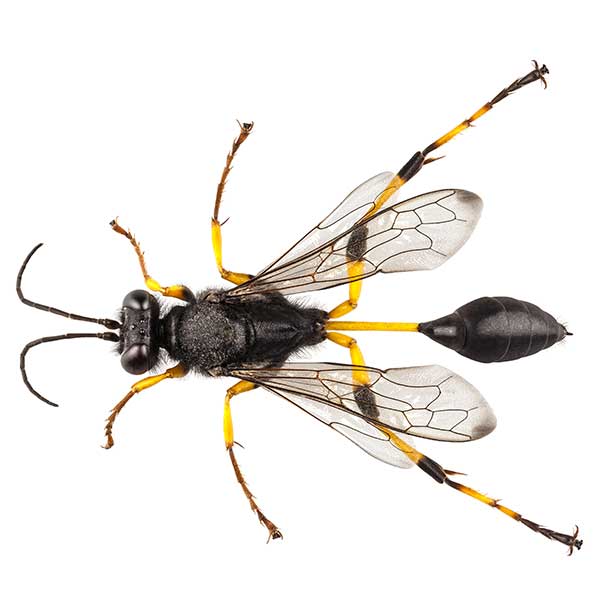Pest Description
Mud Daubers Description
After mating in the fall, the female mud dauber wasp hibernates. Only the fertilized female reproductives will typically survive the winter and emerge in the spring to start a new colony. The queen lays and raises the first batch of eggs. These are workers, which when mature take over the role of feeding the queen, tending the new eggs, and enlarging the hive. In the fall sexual activity begins with the hatching of males and new potential queens.
Late summer is the time when mud daubers create the greatest problems. The colonies have increased and population may be outstripping the natural food supplies. As a result, these wasps are particularly attracted to fruits, sweets, and decaying matter. They can be found around garbage cans, overripe fruit on or around fruit trees, and most annoyingly at your outdoor meal. Bright clothing and perfumes also can attract late-season these wasps.
As nests are only used once, it may be best to ignore them, unless they are located in your house or an outdoor area that you frequently use. Nests in houses should be removed because they can serve as bases for other household insects (such as carpet beetles and other pests).
The Biology of Mud Daubers
All wasps fall under the beneficial insect category in that they pollinate flowers and are predators of flies, caterpillars, aphids, and other insect pests. However, for people who are allergic to the stings, the problems far outweigh the benefits, and proper means must be taken to avoid being stung. This is not to say for those of us who are not allergic should be unconcerned about getting stung. Even if you are not allergic you will most likely experience quite a bit of pain after a sting. It is best for people who are known to be sensitive to stings to consult a professional to rid homes, businesses, and yards of pests.
In order to identify these pests it is helpful to understand each of the following pest’s nature and lifecycle. The social wasps (i.e. Yellowjackets, Hornets, and Paper Wasps) are ones that we see most frequently. The easiest way to distinguish the difference wasps is to look at the size of the wasp and the pattern on the abdomen. Most workers will survive only a season while reproductive wasps will survive over winter and start up each spring depending on weather conditions.
Mud Dauber Wasp – Control & Removal
Stinging insects such as Wasp, hornets and bumble bees can be a serious pest problem for some customers if the nest is located in an area where there is pedestrian traffic. A trained pest management professional is crucial to resolving your stinging insect problems. Comprehensive stinging insect service includes three steps:
- Inspection. A thorough inspection and interview with the customer can determine the level of activity in and around the structure as well as specific location(s) of nesting sites. Based on the technicians findings and information from the customer we can make a proper diagnosis of the treatment strategy as well as recommendations for prevention in the future.
- Treatment. Typical treatment options may include outside application and/or removal of the nest to alleviate immediate concerns from pest pressures in and around the structure as well discourage infestations in the near future.
- Follow-up. Treatment for wasps, hornets and other stinging insects can be very effective. However, due to the relative short lifespan of environmentally friendly products, regular follow-up treatments are recommended to protect the home against future infestations. Quarterly perimeter treatments around the exterior of the home are a great way to ensure your home stays free from infestations as well as help with other pest issues in and around your home and/or structure.









